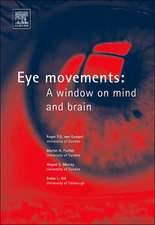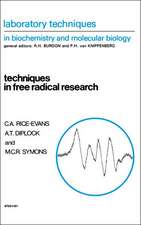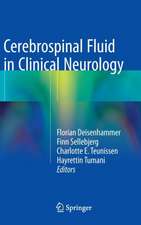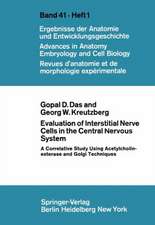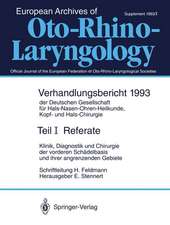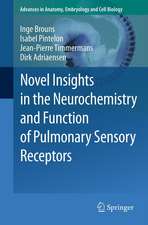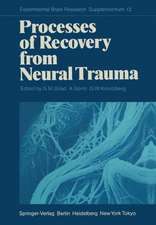The Facial Nerve: An Update on Clinical and Basic Neuroscience Research
G. W. Kreutzberg Editat de E. Stennert, O. Michel M. Jungehülsingen Limba Engleză Paperback – 18 dec 1994
Preț: 385.57 lei
Preț vechi: 405.87 lei
-5% Nou
Puncte Express: 578
Preț estimativ în valută:
73.80€ • 80.19$ • 62.03£
73.80€ • 80.19$ • 62.03£
Carte tipărită la comandă
Livrare economică 21 aprilie-05 mai
Preluare comenzi: 021 569.72.76
Specificații
ISBN-13: 9783540576860
ISBN-10: 354057686X
Pagini: 604
Ilustrații: XXVIII, 575 p. 174 illus., 20 illus. in color.
Dimensiuni: 155 x 235 x 32 mm
Greutate: 0.84 kg
Ediția:Softcover reprint of the original 1st ed. 1994
Editura: Springer Berlin, Heidelberg
Colecția Springer
Locul publicării:Berlin, Heidelberg, Germany
ISBN-10: 354057686X
Pagini: 604
Ilustrații: XXVIII, 575 p. 174 illus., 20 illus. in color.
Dimensiuni: 155 x 235 x 32 mm
Greutate: 0.84 kg
Ediția:Softcover reprint of the original 1st ed. 1994
Editura: Springer Berlin, Heidelberg
Colecția Springer
Locul publicării:Berlin, Heidelberg, Germany
Public țintă
ResearchDescriere
The intention of the VIIth International Symposium on the Facial Nerve was to create a platform for an extensive exchange of knowledge and scientific infor mation between clinicians and basic research workers. This aim could only be realized on the basis of a common interest in the facial nerve, which unites the interdisciplinary scientific efforts of otologists, neurosurgeons, facial plastic surgeons, neurologists, neurophysiologists, and neuroanatomists. Therefore, a meeting of this kind remains in its aim to exchange ideas over scientific disciplines which do not come unique together normal conditions. The symposium has been held every four years since 1966. The VIIth sym posium was preceded by symposia in Stockholm (1966), Osaka (1970), ZUrich (1976), Los Angeles (1980), Bordeaux (1984) and Rio de Janeiro (1988), and marked an important milestone in the continuously developing knowledge about the facial nerve, its physiology, disorders, diagnostics and treatment. In contrast to the previous meetings this symposium extended in vitations to both clinicians and basic research workers. More than 350 scientists from 25 different nations met in Cologne, Germany, in June 1992 and their high-level presentations contributed to the overwhelming success of this international meeting. The symposium took place in the vicinity of the old cllthedral of Cologne, itself a vivid symbol of never-ending efforts to create something perfect and lasting.
Cuprins
I: Invited lectures.- Anatomy.- Comparative anatomy of the central representation of the facial nerve.- The facial nerve — Peripheral and central connections of proprioception.- Facial nerve fiber orientation, linkage between central nervous organization and muscular function.- Changing ratio between myelin thickness and axon caliber in developing human facial nerves.- The denervated muscle.- To what extent can poor functional recovery of denervated muscles be attributed to incomplete as opposed to inappropriate reinnervation after surgical repair of severed nerves?.- Morphologic studies on human and rodent facial muscles.- Denervation and reservation of muscle: Physiological effects.- Postdenervation muscular changes in facial paralysis.- Effects of electrostimulation therapy: Enzyme-histological and myometric changes in the derivated musculature.- Rehabiliation of facial expression (“mime therapy”).- The injured nerve.- Fine Structure of degeneration and regeneration of peripheral nerve fibers.- Regulation of transferrrin receptors and iron uptake in normal and injured nervous system.- Clinical experience in nerve grafting.- Prognostic value of electroneurography in Bell’s palsy.- Role of laminin for axonal growth.- Bell’s palsy: Synopsis by an otologist.- Role of oncogenes in neural regeneration.- The facial nucleus and its cellular environment.- The role of microglia in regeneration.- The role of calcitonin gene-related peptide in the regenerating facial nucleus.- The role of astrocytes in facial nerve regeneration.- Pathophysiology of hemifacial spasm.- II: Free papers and posters.- Anatomy and the denervated muscle.- Anatomy and histology of the mimic muscles and the supplying facial and posters nerve.- Motor innervation pattern of the orbicularis oris muscle in guinea pig.- Why does the frontalis muscle “never come back”? Functional organization of the mimic musculature.- Affection of mimic muscles, simulating damage of the facial nerve in patients with faciocapulohumeral muscular dystrophy.- Muscle ultrastuctural changes in long-standing idiopathic total facial nerve palsy.- Comparison of myosin in denervated and immobilized muscles.- Respiratory-related electromyographic activity of facial muscles.- Stimulation of the regeneration process in denervated muscle.- Peripheral communication of the facial nerve at the angle of the mouth.- Development and reinnervation of rat muscle grafts in interspecific transplantations.- Trigeminal facial nerve communication and its clinical application.- Observations on the geniculate ganglion in adult human dissections.- Spatial occupancy of the facial nerve in the fallopian canal.- Funicular structure and nerve fiber topography in the extratemporal facial nerve.- Physical training.- The role of physical therapy in patients with facial paralysis — State of the art.- Functional recovery and electromyographic/electroneurographic evaluation in Bell’s and Ramsay-Hunt’s palsy patients undergoing physical training.- Treatment of facial paralysis using electromyographic feedback — A case study.- Eutrophic electrical stimulation in long-standing facial palsy.- Plastic surgery.- Graft hypoglossal-facial anastomosis with gold lid weight.- Individually adjusted curvatures of upper eyelid gold implants: a valuable approach.- Static suspension of Eyebrow with Gore-Tex Plastic surgery.- Temporalis transfer for correction of lagophthalmus.- Pectoralis minor transplantation in the Netherlands.- An experimental model for complex dynamic control of the reinnervated face.- Pectoralis minor muscle graft for the treatment of unilateral facial palsy.- Extended follow-up study of vascularized muscle transplantation for treatment of long-standing facial palsy.- Eye sphincter substitution schemes.- Reanimation schemes for partial facial palsies.- Freeze-thawed skeletal muscle autografts: Experimental evalutation of these grafts in facial nerve repair.- Facial nerve paralysis: Gold weight implants as alternative to tarsorrhaphy.- Facial reanimation in facial paralysis.- Facial nerve disorders in children and Others.- Steroid therapy for facial nerve palsy in children.- Developmental aspects of the facial canal: A light and scanning electron microscopy study.- Vulnerability of the facial nerve in entraped palsy: Comparative study in guinea pigs and humans.- Melkersson-Rosenthal syndrome: Report of two cases and review of literature.- Course of the facial nerve in congenital dysplasia of the external auditory canal: A high-resolution computerized tomography study.- Lyme borreliosis — Main cause of acute peripheral facial palsy in childhood.- Dehiscences in the fallopian canal.- Macrodissection study on peripheral facial nerve branches to Stensen’s duct.- Grading of facial palsies.- The quantification of synkinesis and facial paralysis.- Development of a sensitive clinical facial grading system.- Development of a new paresis scoring system for pre- and postoperative evaluation of facial paresis.- Prediction of prognosis in facial nerve palsy using constellation diagram.- Computer-assisted grading of facial function.- Subjective evaluation of facial function by the patient.- Comparative value of facial nerve grading system.- Botulinum toxin.- Treatment of hemifacial spasm with botulinum toxin.- Botulinum toxin treatment in patients with facial sykinesis.- Botulinum toxin: Structure and pharmacology.- Diagnostic procedures Electrophysiology.- The utility of single-fiber electromyography in facial nerve paralysis.- Computer-aided neuromyography with repetitive stimuli for diagnostis of facial nerve disorders.- Antidromically evoked facial nerve response on guinea pigs with partial nerve injury.- Antidromically evoked facial nerve responses in human subjects: Modification of recording techniques.- Electrophysiological evidence for central hyperexcitability of facial motoneurons in hemifacial spasm.- Prognostic diagnosis of peripheral facial palsy by an impedance method.- Facial nerve antidromic evoked potentials.- Infraorbital (V2) and mental (V3) nerve stimulations produce correspondingly specific facial nerve reflexes analogous to the blink reflex.- Electrophysiologic evaluation of facial nerve: Function after paralysis.- Clinical value of battery electrodiagnostic test.- Diagnostic procedures: Electroneurography.- Electrical evaluation of the facial nerve in acoustic neuroma patients comparing transcranial magnetic stimulation and electroneurography.- The prognostic value of electroneurography in Bell’s palsy.- Innervation pattern of the extratemporal ramification of the facial nerve; intraoperative evoked electromyographic study: Second report.- Bell’s palsy and magnetic stimulation: longitudinal study.- Electromyography of evoked activity of the facial nerve in cerebellopontine angle surgery.- Electroneurographic evaluation of facial palsy: Early and late results in 350 patients.- Neuronography in facial palsy-results of long-term observations.- Magnetic stimulation.- Identification of the exact stimulated site in transcranial magnetic stimulation of the facial nerve.- Pre- and postoperative electrophysical and magnetic stimulation control of facial nerve function in hemifacial spasm.- Influence of different electrodes on electric and magnetic stimulation of the facial nerve.- Evaluation of peripheral facial palsy by transcranial magnetic stimulation.- Transcranial magnetic stimulation of the facial nerve in small and medium-sized acoustic neurinomas.- Neurophysiological evaluation of Bell’s palsy: Electroneurography and transcranial magnetic stimulation.- Magnetic stimulation in patients with essential blepharospasm and hemifacial spasm.- Blink reflex investigation using magnetic stimulation.- Facial nerve lesions: tumor, trauma.- Progressive facial palsy and neurinomas of the VIIth nerve.- Two cases of intratemporal facial neurofibroma.- Facial nerve neuronomas: Diagnosis and management of the large lesion.- End-to-end anastomosis versus nerve graft in intratemporal and intracranial lesions of the facial nerve.- Primary facial nerve tumors: Diagnostic and management dilemmas.- Gunshot injuries to the intratemporal facial nerve.- Microsurgical selective removal of benign neoplasms of the parotid gland.- Peripheral facial nerve paresis as the initial presenting manifestation of tumors of unknown origin.- Facial nerve neurinoma nad otologic signs.- Facial paralysis induced by tumors.- The facial nerve in congenital ear malformations.- Management of traumatic facial nerve paralysis with carotid artery cavernous sinus fistula.- Facial nerve neuroma.- The acoustic trauma in decompression surgery of facial nerve.- Recovery of total facial palsy after neuroma surgery.- Facial nerve monitoring.- Intraoperative NIM-2™ monitoring for facial nerve preservation in acoustic neurinoma surgery.- Facial nerve monitoring of skull base and cerebello-pontine angle lesions..- Intraoperative facial nerve monitoring by monopolar low constant current stimulation and postoperative facial function in acoustic tumor surgery.- Intraoperative facial nerve monitoring in the infratemporal fossa approach: Improved preservation of nerve function.- Electrical stylomastoidal and magnetic transcranial stimulation of the facial nerve in Bell’s palsy: Time course of electrophysiological parameters.- Facial nerve imaging.- Gadolinium-DTPA-enhaneed MRI of the facial nerve.- Gadolinium-enhanced MRI and positron emission tomography in Bell’s palsy: A preliminary report.- Correlation between Gadolinium-enhanced MRI and neurophysiology in Bell’s palsy: A preliminary study.- Gadolinium-DTPA-enhanced MRI in facial palsy.- Correlation of MRI, clinical, and electroneuronographic findings in the natural course of acute facial nerve palsies.- Hemifacial spasm: Evaluation and management options.- Idiopathic facial nerve palsy (Bell’s palsy): Morphological changes in MRI.- Contrast-enhanced MRI of the facial nerve in patients with Bell’s palsy.- Gadolinium-enhanced MRI in experimental facial nerve paralysis.- Preoperative radiologic assessment of facial nerve in cochlear implant surgery.- Gadolinium-enhanced MRI in Bell’s palsy.- Hemifacial spasm caused by posterior inferior cerebellar artery elongation — diagnostic value of angiomagnetic resonance imaging.- Computerized tomography demonstration of labyrinthine facial nerve decompression viability by the transattical approach.- Depiction of affected facial nerve with Gd-DTPA enhanced MRI.- Idiopathic facial nerve palsy (Bell’s palsy): Morphological changes in MRI.- High-resolution computed tomography imaging of the facial nerve canal in temporal bone fractures.- Facial palsy due to intracranial vascular lesion.- Imaging in the differential diagnosis of facial paralysis.- Value of MRI and intraoperative frozen sections in defining the extent of facial neurinoma.- Topographical anatomy of the facial nerve.- X-Ray symptomatology of the facial canal involvement in chronic otitis.- Surgical techniques.- Clinical investigation of hypoglossal-facial nerve anastomosis.- Salvage decompression of the facial nerve.- Is facial nerve decompression surgery effective?.- Surgical treatment of synkinesis.- Parotidectomy with the nerve integrity monitor II.- Anastomosis of infratemporal facial nerve with fibrin tissue adhesive.- Treatment of facial paralysis in humans by neural methods.- Facial reanimation by XII to VII nerve anastomosis after surgery on the VIII nerve.- Rehabilitation after hypoglossus-facial crossover.- Development of the nerve conduction velocity after hypoglossal-facial nerve anastomosis: An electroneurographie study.- The “babysitter” principle: Experience and results in 25 cases.- Trigeminal neoneurotization of the paralysed facial musculature.- Surgical repair of the facial nerve at the base of the skull: The mastoid-parotid approach.- Microvascular decompression by the retromastoid apporach for idiopathic hemifacial spasm: Experience of 300 patients.- Endoscopic anatomy of the facial nerve and related structures.- Facial nerve research: New approaches and results.- Expression and regulation of neuropeptides in rat facial motoneurons.- Human facial nucleus: Choline acety and calcitonin gene-related peptide.- Nerve growth factor: Morphological and morphometrie findings of facial nerve regeneration in the rabbit.- Observation of motorneurons after recovery from experimental facial nerve paralysis.- Extracellular matrix arrangements of rat facial nerve.- Best method for facial nerve anastomosis.- An animal model of ischemic facial palsy.- Experimental studies on antidromic evoked potential of the facial nerve.- Function-dependent expression of calcitonin gene related peptide in neuromuscular junctions of the facial muscles.- Ultracytological localization of K+-dependent, p-nitrophenylphosphatase activity in cat facial nerve.- Degeneration and regeneration of neuromuscular junction in guinea pig mimic muscle — A scanning electron microscopic study.- Nerve growth factor: Optic and ultrastructural findings on facial nerve degeneration in the rabbit.- Stereological estimation of the volume and neuron number of the facial and hypoglossal nucleus of the rat.- Effects of motor neuron disorders on feeding behavior of sturgeons, inhabiting the volga river.- Detection of varicella zoster virus DNA by polymerase chain reaction in clinical samples from patients with Hunt’s syndrome.- Stereological evaluation of neuronal plasticity in rat brainstem after hypoglossal-facial anastomosis.- Role of opioid peptides and substance P in the regeneration of CNS and PNS nervous tissue.- Reinnervation of rat vibrissae after hypoglossal-facial anastomosis: A horseradish-peroxidase study.- Biomaterials used in nerve regeneration chambers as substrata for spinal cord neurons cultured in vitro.- Fibrin sealant (Tissucol) as a substratum for spinal cord neurons cultured in vitro.- Facial nerve regeneration through semipermeable porous chambers.- Comparison of rabbit facial nerve regeneration in nerve growth factor-containing silistic tubes to autologous cable grafts.- Carbon dioxide laser repair of the facial nerve: An experimental study in the rat.- A new animal model of facial nerve palsy using a freezing method.- Immunology.- Etiopathogenesis of Bell’s palsy: An immune-mediated theory.- T-Lymphocyte subpopulations and HLA-DR antigens in patients with Bell’s palsy, hearing loss, neuronitis vestibularis and Menière’s disease.- Electrophysiologic pattern and T-cell subsets in Bell’s palsy.- Immunological findings in Bell’s palsy.- Prevalence of Borrelia burgdorferi antibodies in Bell’s palsy in a metropolitan area of northern Italy.- Anti-Borrelia burgdorferi antibodies in sera of patients with facial paralysis.- Macrophages and Schwann cells in myelin disintegration.- Incidence of peripheral facial palsy in patients with antibodies against Lyme Borreliosis.- Blood supply.- Reaction of the vasa nervorum of the facial nerve during stimulation with neurotransmitters.- Morphological changes in ischemic facial nerve paralysis.- Activation of intravascular coagulation in Bell’s palsy.- Retinal videofluorescence-angiographic findings in Bell’s palsy.- Evaluation of total and perfused blood vessels in the facial nerve.- Viral involvement.- Virus isolation study of the human ganglion geniculi (nerve VII).- Virus-associated demyelination in the pathogenesis of Bell’s palsy.- Histopathology of facial nerve neuritis caused by herpes simplex virus infection in mice.- Herpes simplex virus and experimental facial paralysis.- Recent treatment of Ramsay Hunt syndrome.- Herpes zoster of the geniculate ganglion: Therapeutic concepts.- Acyclovir versus steroids in the treatment of Bell’s palsy.- Facial palsy and human immunodeficiency virus infection.- Antibody response against the Epstein-Barr-virus in acute idiopathic facial palsy.- Lower brainstem changes in herpes oticus with facial palsy.- Facial nerve paralysis induced by herpes simplex virus infection in mice.- Ramsay Hunt syndrome: Natural history.- Evidence suggesting the viral etiology of Bell’s palsy.- Bell’s palsy and others.- Management of Bell’s palsy accompanied by diabetes mellitus.- Long-term results of severe facial paralysis.- Distribution of facial nerve conduction velocities in patients with Bell’s palsy.- Tertiary syphilis with facial paralysis.- Recurrent facial paralysis associated with HIV infection.- Bilateral facial palsy in Wegener’s granulomatosis.- Facial palsy in Equatorial Africa.- Regeneration of irradiated rat skeletal muscle after damage under different experimental conditions.- Age characteristics of reinnervation of skeletal muscle grafts.- Prediction of surgical criteria for Bell’s palsy on the fifth day of evolution.- Therapeutic policy for Bell’s palsy and Hunt syndrome.- Stellate ganglion block for facial palsy.- Treatment comparison between dexamethasone and placebo for idiopathic facial palsy.- Emotions in the first 99 days after the onset of facial paralysis: A single case study.- Facial paralysis in children.- Evaluation of facial palsy by Moiré topography.- Bell’s palsy steroid therapy in chosen cases.- Result of high-dose steroid therapy (Stennert) in facial palsy.- Natural history of Bell’s palsy.- The facial nerve nucleus.- Central and peripheral rearrangements following hypoglossal-facial crossover: An electrophysiological study.- Recovery of normal excitability of the facial motor nucleus following facial nerve decompression in hemifacial spasm.- Astroglial response in facial and hypoglossal nucleus after hypoglossal-facial anastomosis in the rat.- Synaptic stripping in facial and hypoglossal nucleus after hypoglossal-facial anastomosis in the rat.- Response of Nissl substance in the facial and hypoglossal nucleus after hypoglossal-facial anastomosis in the rat.- New “perineural cells” in the compartmentation of the regenerated nerves.- Somatotopic changes of the stylohyoid muscle subnucleus after section and repair of the facial nerve.- Axotomy of the facial nerve not only induces changes in the facial nucleus but also in remotely related brain regions.- To: Bell’s palsy and others.- Peripheral facial paralysis: evaluation of effects in a case-study.

